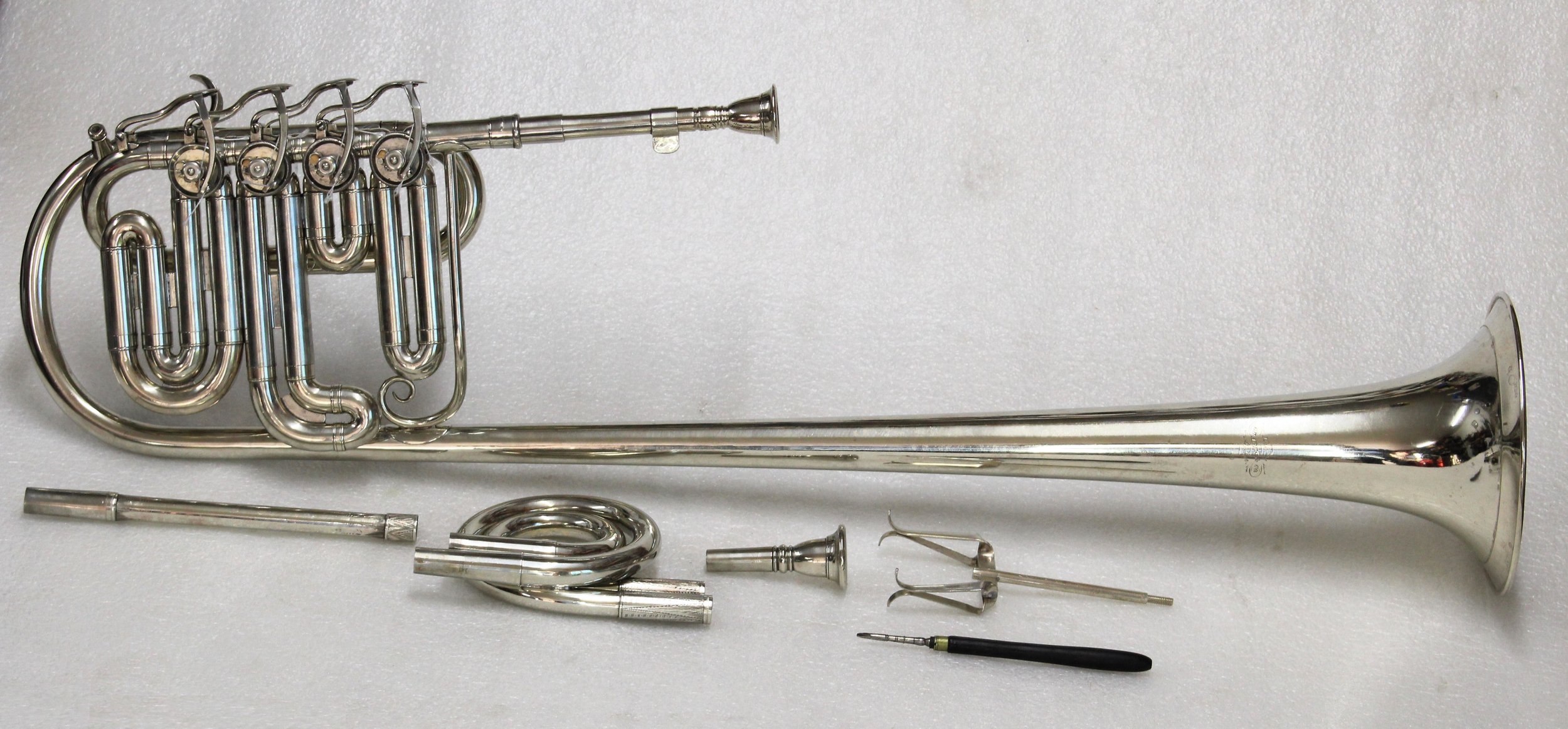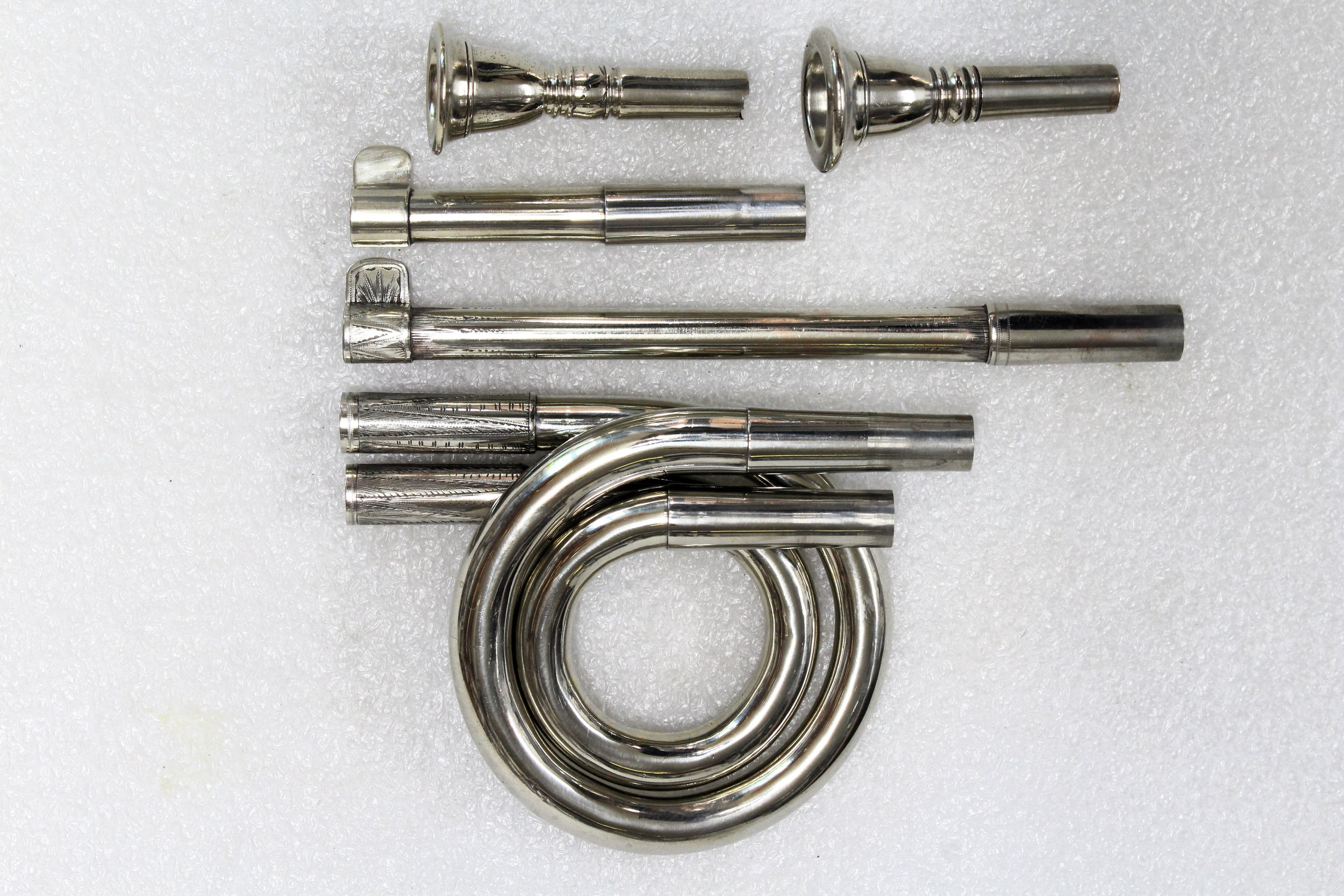Graves & Co. Bb Cornets
There are only two Bb cornet with bells over the shoulder made by Graves & Co. known to exist, both featured here. The first, and most impressive, is in Mark Elrod’s collection. It has survived for over 160 year mostly intact and relatively little damaged. Based on details of design and construction, it was most likely made before 1856, which was about eight years after the earliest examples of rotary valve instruments made in the US (excluding the mysterious trumpet by Nathan Adams) and no more than four years after the earliest by Graves.
It retains most of its original parts including the very well constructed case. It is unique among known Bb instruments by Graves for the wider, saxhorn style bell, which appears to be the same as that used on Graves Eb sopranos. Closer examination reveals other interesting details in this instrument. Those that indicate possible early date of manufacture include rotary valve bodies that are cylindrical rather than tapered and unusual position of the string screws on the stop arms. The threaded holes for these are extremely shallow, about 1 1/2 threads and the screws have to clamp the arm in place at the same time that they are clamping the string. They are prone to stripping. One was missing and at least one other had already been replaced with a larger diameter thread. It’s not surprising that this design was not continued. It is also very lightly braced. It seems that in the early years of brass instruments they were treasured and handled with great care and reverence, not as a blunt tool to toss around.
In the second photo above, notice that the numbers stamped on the valve casings are “2, 1, 3, 4”. There is no traces that indicate that number 2 ever had a lever mount soldered on it, indicating that the valve section was originally constructed with the half step first, what we now call “catholic fingering”, which was not uncommon at the time. The first two valve assemblies were switched before the rest of the instrument was built.
Traces of a lozenge shaped brace flange can be seen on the mouthpipe receiver in the third photo above. Very close examination of the instrument finds no other previous or missing braces. One possible explanation for this detail is that the receiver had been installed on another instrument. It could have been installed on this instrument either during original construction or as a modification that allowed the use of the set of shanks and crooks. Notice that the Bb crook lacks the engraved decoration of the others and the two shanks have flag style grips. Most Graves Bb cornets don’t have any aid for gripping the shanks and later instruments have a pair of knobs. The source instrument was likely decorated in this style. One of the two mouthpieces found with this instrument is noticeably more crudely made, indicating that they were not made at the same time or by the same maker. They are both from the period and were most likely made in Boston.
Also unusual, is the length of the fourth valve tube. It was common to lower the pitch one, two or five semitones. Less commonly, it would raise the pitch by a whole tone as in the Richardson circular cornet featured elsewhere on this site. In this case, it lowers the pitch by four semitones, or the same as the second and third valves together. This isn’t a bad choice, since the practical range is short of the pedal notes and still can be used for a variety of alternate fingerings throughout the range.
The overall length of this cornet is 24 5/16”, the bell rim diameter is 4 15/16”, the bore thought the valves is .434” and through the tuning slide is .454”.
For more than a decade, the cornet featured below was the only Graves Bb cornet with the bell over the shoulder known and that's just part of the story. The photo below of the tarnished bell is as found and is the only part of the cornet that is original. This cornet was made for the Lawrence Brass Band. Lawrence, Massachusetts was a 9 year old mill town 25 miles north of Boston, when the band was formed in 1849.
After it was found, Mark Elrod, Bob Eliason and other experts in the field were consulted to confirm its uniqueness. The next thought was to reproduce all the missing parts. It was a very time consuming project but had no deadline. It was completed over the course of about two years in between customers’ work.
Click on an image for larger views.
The very narrow shape of the bell flare on this cornet is unique among American Bb cornets known from the 1850s, although wider than the “post horns” of the previous decade. It must have been an early design by Graves & Co. to make a Bb cornet more like the French examples that were becoming popular. More typical among other makers would be a large cornet bell descended from early English cornopeans and seen in Fiske circular cornets or a Courtois cornet style bell as seen on the Graves circular, E.G. Wright and Boston cornets.
This cornet is 24 1/4" long, the bell rim diameter is 4 15/16" and the bore measures .438". The bore of the original valve section, indicated by other Bb cornets from the early to mid-1850s, would likely have been somewhere between .425" and .435". The mouthpiece is from the period by Allen & Co. in Boston.
Since there was no complete cornet like this in any known collections, it is surprising that we know of at least three original photographs from the 1850s of musicians holding very similar instruments including one from the famous Colt Armory Band. The copy of an original photo shown here was provided by Tom Meacham. The second image is a composite of these three, images showing similarities and differences. Two of these three appear to have detachable bells. The Burlington example appears to have a bell with more conventional proportions (Courtois design) as in the known circular models by Graves & Co. These photographs are clear enough to get the proportions and details very accurate and the reconstruction was also informed by details of the mechanisms in five or six original Graves cornets that were examined.
The detachable bell indicates that it had been supplied with an alternate bell that faced forward or, more likely, upwards. Pictured below is a Graves Eb soprano with interchangeable bells. A very similar Eb cornet is part of a set delivered to the Samuel Colt's Armory Band early in 1856, which now is part of the Boston Museum of Fine Arts collection. The Bb cornets from that set aren't know to exist today, but there is an original photograph of one of Colt's musicians holding one reproduced in Garofalo and Elrod's book on Civil War era instruments and bands. For more information on “convertible” instruments by Graves & Co., click this link.


















